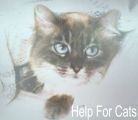Hello:
I have 6 cats and Lover is the oldest - approximately 11 years old. He is an obese cat and has radial patellar laxation in both his hind legs (I think it is called). By now he has some pretty bad arthritis in his joints, too. He doesn't get around too well but is still just like any other cat. We limit his food but it doesn't seem to matter. He also has had several episodes of FUS over the years and several surgeries to get him unblocked and remove the stones (both kinds).
Well, now he has this huge swelling that keeps appearing on the back of his neck. Well, it seems huge to me. At first I thought it was just weight showing up back there. It is below his skull. It is a soft mass that is totally symetrical so I think it is just some kind of fluid accumulation but I am not a vet to be sure. I saw it a month or so ago and it seemed to go away. I noticed it again yesterday and it just looks huge to me. I can post a picture, if necessary. I just tried to take some pics but they don't show it well. It is between the base of his skull and before the place where his shoulders come together....the nape of the neck area. It looks like a big fat roll but it is just too big and isn't always there.
Advice would be great. I would really appreciate it.
Theresa A.
Lover
Re: Lover
You need to get your kitty seen and checked by your vet, immediately please. Without knowing anything further, it's impossible to advise.
It could be excess fat buildup, but it could be just about anything else, only your vet can examine him and tell you for certain if this is concerning.
As for the patellar luxation, you need your vet to tell you what you can do for this, short of surgical correction. The weight would be concerning because it's putting added stress and pain to his joints, causing inflammation. There are medications available that can help with this, but ideally, a weight management plan should be seriously considered. Given kitty's age (not to mention prior history of FLUTD), you must approach this cautiously, carefully, and under your vet's explicit instructions only. Weight reduction in cats must be done slowly and carefully, if too much weight is lost too soon, this can predispose a kitty to diabetes or liver failure. The diet must be tailored to fit his individual weight loss management requirements, yet be able to maintain him for FLUTD.
Get a full blood profile done for kitty if you haven't had this done within the last year. Get a full x-ray analysis of the patellars to determine if this is dengerative joint disease or inflammation that can be treated with meds or cosequin.
It could be excess fat buildup, but it could be just about anything else, only your vet can examine him and tell you for certain if this is concerning.
As for the patellar luxation, you need your vet to tell you what you can do for this, short of surgical correction. The weight would be concerning because it's putting added stress and pain to his joints, causing inflammation. There are medications available that can help with this, but ideally, a weight management plan should be seriously considered. Given kitty's age (not to mention prior history of FLUTD), you must approach this cautiously, carefully, and under your vet's explicit instructions only. Weight reduction in cats must be done slowly and carefully, if too much weight is lost too soon, this can predispose a kitty to diabetes or liver failure. The diet must be tailored to fit his individual weight loss management requirements, yet be able to maintain him for FLUTD.
Get a full blood profile done for kitty if you haven't had this done within the last year. Get a full x-ray analysis of the patellars to determine if this is dengerative joint disease or inflammation that can be treated with meds or cosequin.
..........Traci

